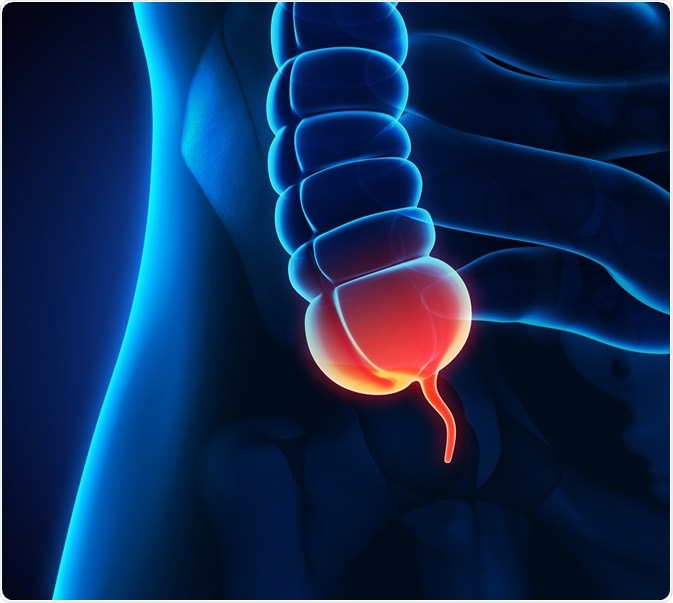Pseudomyxoma peritonei (PMP) is a rare, chronic, and often misdiagnosed disease defined by the dispersed mucinous ascites and tissue lining the peritoneal cavity, and generally initiate from appendix cancer or ovarian cancer.

PMP typically originates in the appendix. Credit: Nerthuz/ Shutterstock.com
In comparison with other digestive cancers, PMP is a very slow developing tumor. The motive of the pathologist while treating patients affected with PMP is to attempt to eliminate the unusual tissue and tumors inside the abdomen and to assure them a long-term survival.
Treatments for PMP
Depending on the patient’s health condition, and the amount of tumors and their progression level, the treatments vary.
1. Observant waiting
As PMP is a slow developing tumor, the doctor may recommend watchful waiting. In this practice, the patients are suggested to have regular checkups, but there is no treatment until the symptoms arise. The aim is to closely monitor the PMP and control it rather than to cure the disease.
When the symptoms begin to cause problems for the patient, the doctor plans for a mode of treatment to be followed.
2. Surgery
The most important treatment for PMP is surgery. A doctor schedules the treatment plans depending on the level at which the tumor has progressed and on the patient’s health condition. In the surgical procedure, a pathologist removes the lining of the peritoneum and eliminates the unusual tissue inside the abdomen that is affected by the PMP.
Surgery for PMP can be divided into two types: Cytoreductive surgery with hyper-thermic intraperitoneal chemotherapy (HIPEC) and Debulking surgery.
Cytoreductive surgery with HIPEC
Cytoreductive surgery with hyper-thermic intraperitoneal chemotherapy (HIPEC) is an important and advanced method to treat tumors. The motive of a pathologist in this treatment is to eliminate the tumor in the abdomen and attempt to cure PMP. This technique is otherwise known as Sugarbaker technique.
Critical complications may develop during the operation, hence a patient should discuss with a pathologist about whether the treatment is suitable or not for him or her.
The first procedure in this treatment is cytoreductive, in which the surgeon removes the entire tumor, although some microscopic cancer cells are left out. Sometimes, it is hard to remove tumors from some organs.
In such conditions, there is a need to remove the organ itself, partially or completely. Organs that may be removed include the gallbladder, the lining of the abdominal cavity, and some parts of the bowel. In females, the ovary or the uterus may be removed in some cases.
This is followed by hyper-thermic intraperitoneal chemotherapy (HIPEC), which is carried out to kill the leftover microscopic cancer cells. During the operation, a heated chemotherapy liquid is put into the peritoneum through a small-sized tube called a catheter.
The chemotherapy solution is used as a drug for destruction of the tumor cells. After 90 min, the operation is over and the solution is drained. After the operation, over the next five days a doctor or a nurse provides more chemotherapy solutions into the peritoneum through the small tube that is connected to the stomach.
During this procedure, some patients may undergo stoma operations. A small opening made in the abdomen is known as a stoma, which is connected to the opening of the bowel. The patient needs to wear a bag on the stoma, which collects the waste matter meant for the bowel. The wearable bag is temporary; after six months, it may be reversed by a small operation.
Debulking surgery
This treatment is given when the entire tumor is not removed by cytoreductive surgery. The pathologist can remove as much of the tumor cells as possible in this surgery. This may not be a cure for PMP; but it decreases the symptoms as well as helps the patient to feel relaxed and comfortable for a longer time.
During the operation, a surgeon can eliminate the omentum (a part of the peritoneum) and also a part of the bowel. They can also remove the reproductive organs (such as ovary or uterus) in women.
Unluckily, in some cases, the entire tumor cannot be removed in this surgery. It is possible for the PMP to grow back from these cells. So a number of debulking surgeries are needed for such patients. However, it is also difficult to do the operation again and again. After debulking, for some patients a permanent stoma is necessary, which helps to prevent blocking of the bowel.
3. Chemotherapy
Patients who have not had cytoreductive surgery are suggested to take chemotherapy. It can help to decrease the development of the PMP as well as the symptoms. In such cases, chemotherapy is given through the tablet capecitabine or through an injection (mitomycin C) into the vein.
This chemotherapy may produce some side effects. By taking regular blood tests and scans, a doctor or nurse can monitor the patient’s condition.
Further Reading
Last Updated: Dec 29, 2022